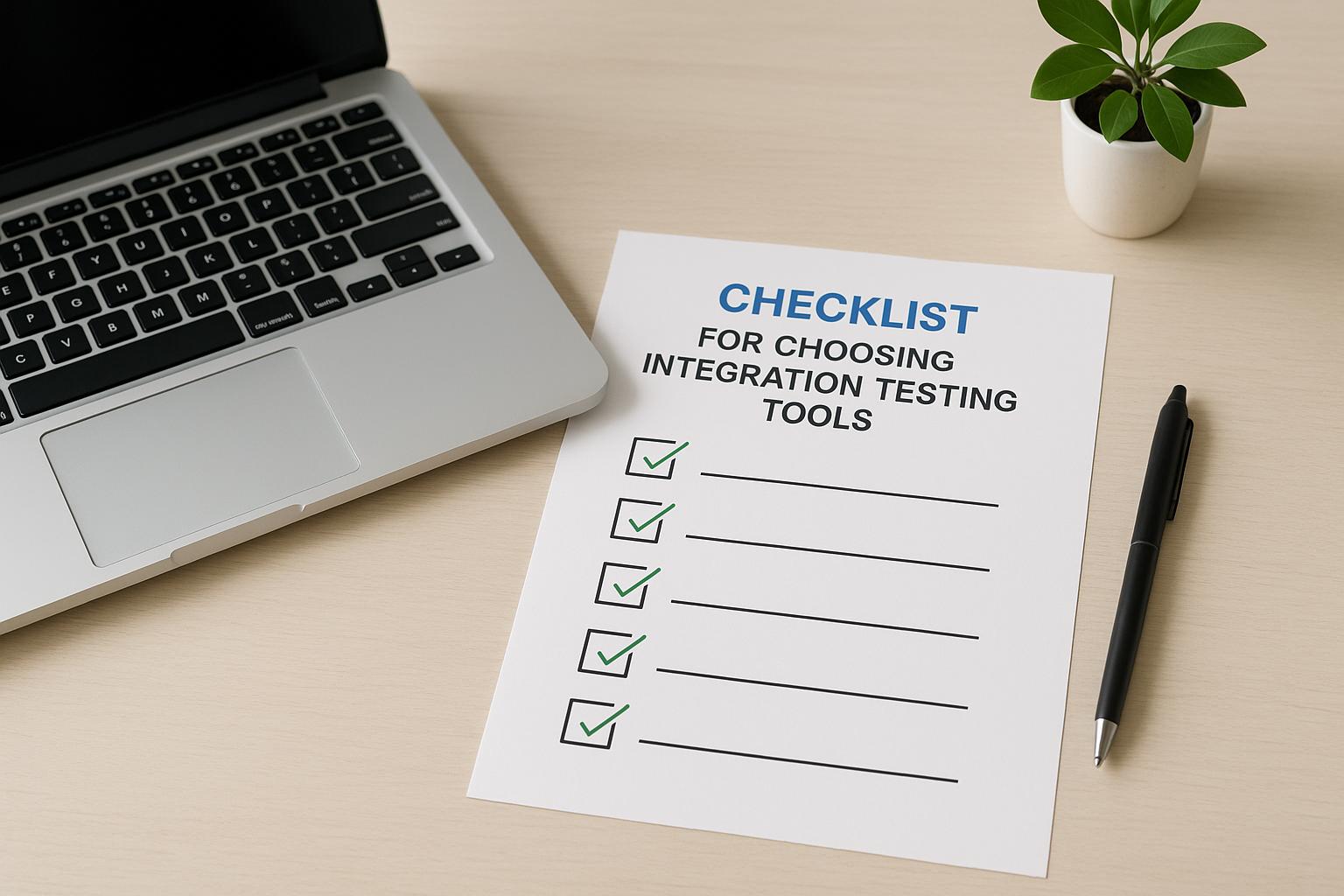- Subscription billing tools help beauty brands handle recurring payments, customer lifecycles, and compliance with U.S. regulations like PCI DSS, ASC 606, and CCPA.
- These platforms reduce churn, improve customer satisfaction with self-service options, and automate financial reporting.
- Advanced analytics offered by these tools provide insights into revenue, customer behavior, and subscription performance.
Key Platforms:
- Chargebee: Flexible billing cycles, dunning management, and deep analytics for established brands.
- Vagaro: Ideal for salons combining appointments with subscriptions.
- GlossGenius: Best for independent professionals, offering simple subscription management.
- Fresha: Free core platform focused on appointment-based businesses.
- Mangomint: Tailored for mid-size salons with client retention tools.
- Recurly: Advanced features for large-scale beauty brands with complex billing needs.
- Maxio: Perfect for growing e-commerce brands needing predictive analytics and flexible pricing.
Quick Comparison:
| Tool | Best For | Key Features | Limitations |
|---|---|---|---|
| Chargebee | Established brands with complex subscriptions | Flexible billing, dunning, revenue analytics | Steeper learning curve, premium cost |
| Vagaro | Salons with product subscriptions | Appointment scheduling, built-in POS | Limited for pure e-commerce |
| GlossGenius | Small studios and professionals | Mobile-first, simple recurring payments | Basic subscription features |
| Fresha | Budget-conscious businesses | Free platform, basic payment processing | Limited customization |
| Mangomint | Mid-size salons | Client retention tools, staff management | Not scalable for larger operations |
| Recurly | Large beauty brands | Advanced analytics, churn prevention | Complex setup, higher cost |
| Maxio | Growing e-commerce brands | Predictive analytics, flexible pricing | Steep learning curve, premium cost |
Takeaway:
Beauty businesses must choose a billing platform based on their size, subscription complexity, and growth plans. Tools like Chargebee and Maxio suit larger operations, while Vagaro and GlossGenius cater to smaller setups. Prioritize features like compliance, analytics, and integration flexibility to support long-term growth.
1. Chargebee
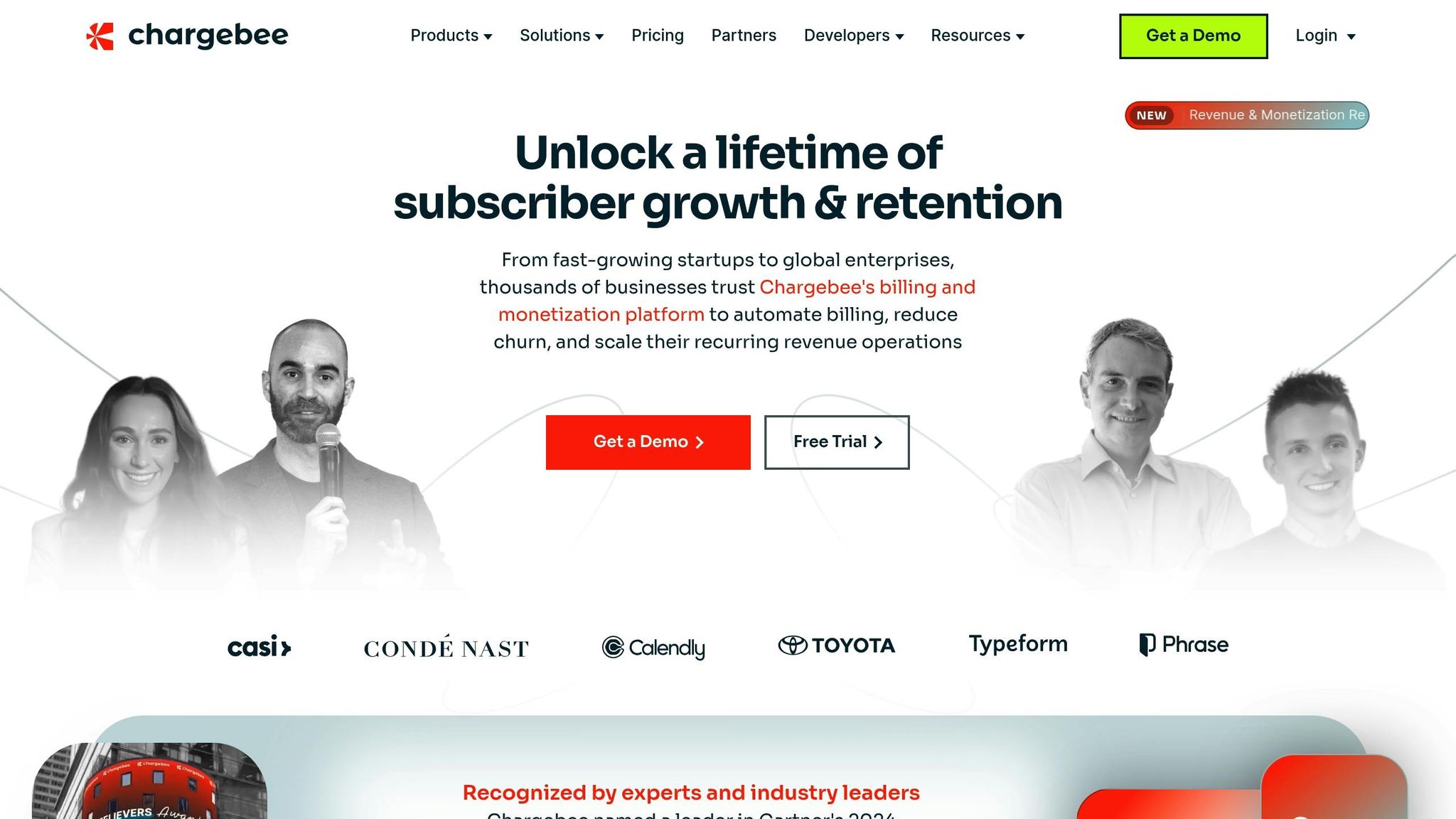
Chargebee is a subscription billing platform tailored for U.S. beauty e-commerce businesses. Whether it’s managing simple monthly beauty box subscriptions or handling complex tiered pricing for premium skincare lines, Chargebee streamlines billing, customer management, and analytics integration, making it a go-to solution for beauty brands.
Recurring Payments
Chargebee stands out in managing the variety of payment scenarios that beauty brands encounter. It supports flexible billing cycles, from weekly shipments to quarterly deliveries, and even allows for proration when customers make mid-cycle changes - like upgrading from a basic skincare plan to a premium anti-aging regimen.
The platform’s dunning system is designed to address failed payments with automatic retries and personalized email reminders. This is especially valuable for beauty brands, where retaining subscription customers is key due to their high lifetime value.
Chargebee supports multiple payment methods, including credit cards, PayPal, and ACH transfers. This versatility ensures customers can choose their preferred payment option, whether it’s a credit card for smaller monthly boxes or a bank transfer for pricier, annual skincare packages.
Beyond payments, Chargebee focuses on improving customer engagement.
Customer Management
Chargebee offers tools to manage the entire customer lifecycle. It segments customers based on their subscription history, product preferences, and engagement levels. This allows beauty brands to run targeted campaigns, like promoting anti-aging products to long-term subscribers or showcasing seasonal collections to highly engaged customers.
With self-service portals, customers can manage their subscriptions independently. They can pause deliveries during vacations, skip a month when they have extra products, or swap items within their subscription tier. This flexibility not only enhances customer satisfaction but also reduces churn and support costs.
Chargebee also integrates with email marketing platforms, making it easy to send automated notifications about upcoming shipments, payment confirmations, or subscription updates. These communication tools ensure customers stay informed and engaged.
Analytics
Chargebee provides powerful analytics to help beauty brands optimize their recurring revenue. Metrics like Monthly Recurring Revenue (MRR), customer acquisition costs, and churn rates are readily available.
Cohort analysis tools allow brands to track customer behavior over time, helping them identify the most effective acquisition channels or fine-tune pricing strategies for different customer segments. The platform also offers revenue recognition reporting that complies with ASC 606 standards, which is crucial for brands seeking investment or preparing financial statements.
Real-time subscription dashboards provide insights into billing health, payment failures, and customer satisfaction. For example, brands can quickly spot trends like seasonal churn spikes or which product categories drive the highest conversions.
Integration
Chargebee integrates seamlessly with e-commerce platforms like Shopify, WooCommerce, and Magento. These connections ensure accurate inventory management, especially for products with expiration dates or seasonal availability.
CRM integrations with tools like HubSpot and Salesforce create a unified customer view by combining subscription data with marketing and customer service interactions. This enables personalized marketing campaigns and better customer support.
For financial reporting, Chargebee integrates with accounting software like QuickBooks and Xero. Revenue recognition, tax calculations, and subscription metrics flow directly into these systems, saving time and improving accuracy for brands managing complex product lines and subscription tiers.
Marketing integrations with platforms such as Klaviyo and Mailchimp allow brands to create email campaigns based on subscription behavior. For example, they can set up automated sequences for subscription anniversaries, recommend products based on purchase history, or re-engage churned customers with tailored offers.
2. Vagaro
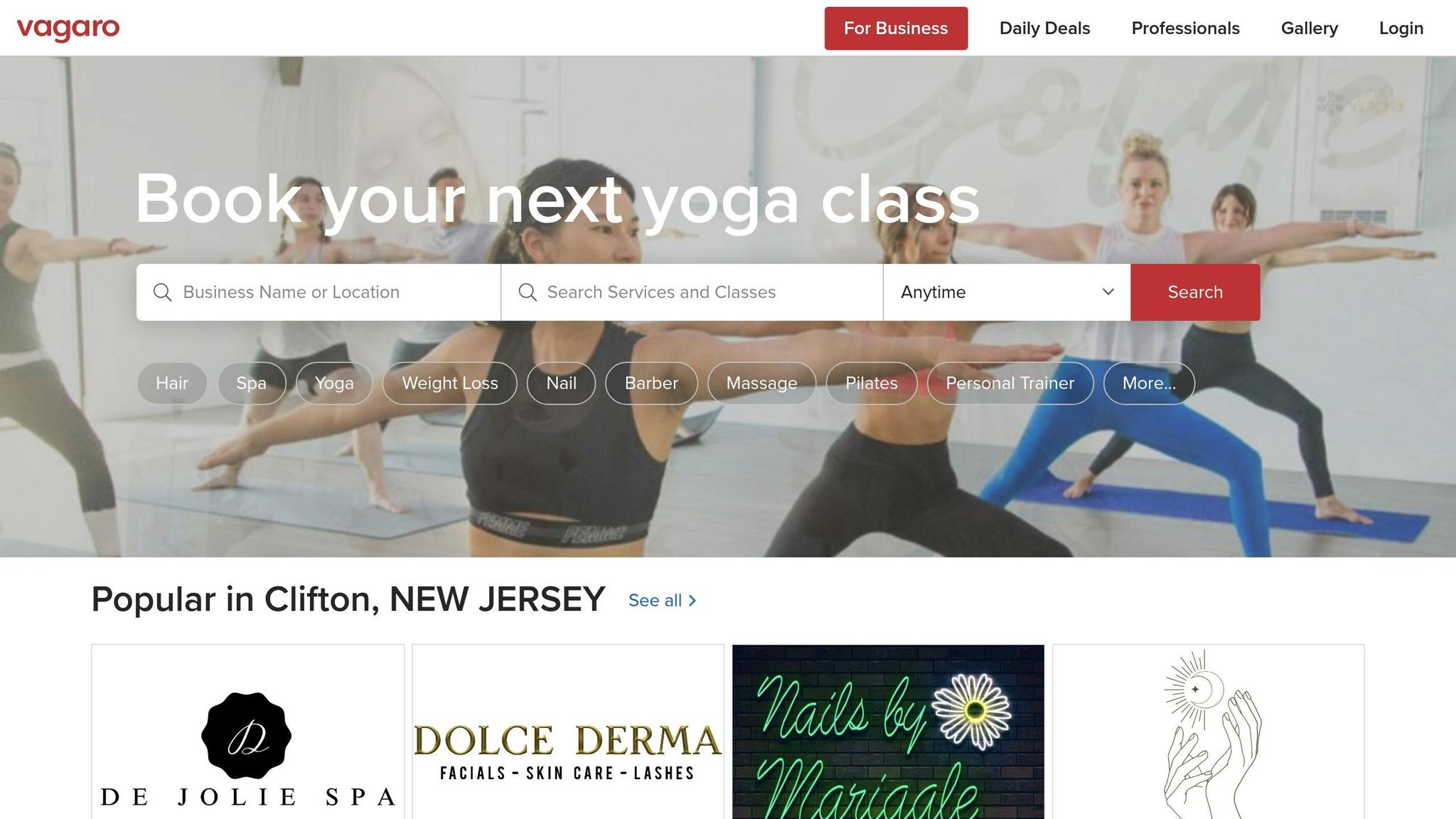
Vagaro is a business management platform tailored for appointment-based services but also supports subscription billing. This makes it a solid choice for businesses that blend service bookings with product subscriptions.
Recurring Payments
Vagaro simplifies recurring billing by integrating it directly with appointment scheduling. This feature is especially useful for businesses in the beauty industry offering membership packages or combined service and membership options. Payments are handled automatically, though the recurring payment tools are more focused on service-based revenue and may lack the depth of dedicated subscription billing platforms.
In addition to payment processing, Vagaro provides a suite of tools to help manage customer relationships effectively.
Customer Management
Vagaro’s customer management features give businesses a centralized hub for tracking client interactions. This includes storing contact details, service histories, and purchase records. Automated communication tools help maintain customer engagement, making it easier to promote subscription packages and retail products.
These customer insights also feed into Vagaro’s analytics tools, which provide valuable business data.
Analytics
Vagaro includes a reporting dashboard that delivers insights into business operations, such as sales, appointments, and service provider performance. The system tracks key metrics like customer retention rates and top-selling retail products. It also offers data on revenue, booking patterns, client retention, service outcomes, and revenue per treatment.
That said, some reviews point out limitations in Vagaro’s analytics. For instance, Dingg.app noted:
reporting feels basic: Limited customization for performance analytics and trend analysis
and mentioned the system:
lacks the analytical capabilities that data-driven businesses typically require
for in-depth subscription analysis.
Integration
Vagaro integrates with various tools like accounting software and email marketing platforms, making it easier to manage reporting and launch targeted campaigns. It also works with inventory management systems and point-of-sale solutions, helping businesses streamline their operations.
3. GlossGenius
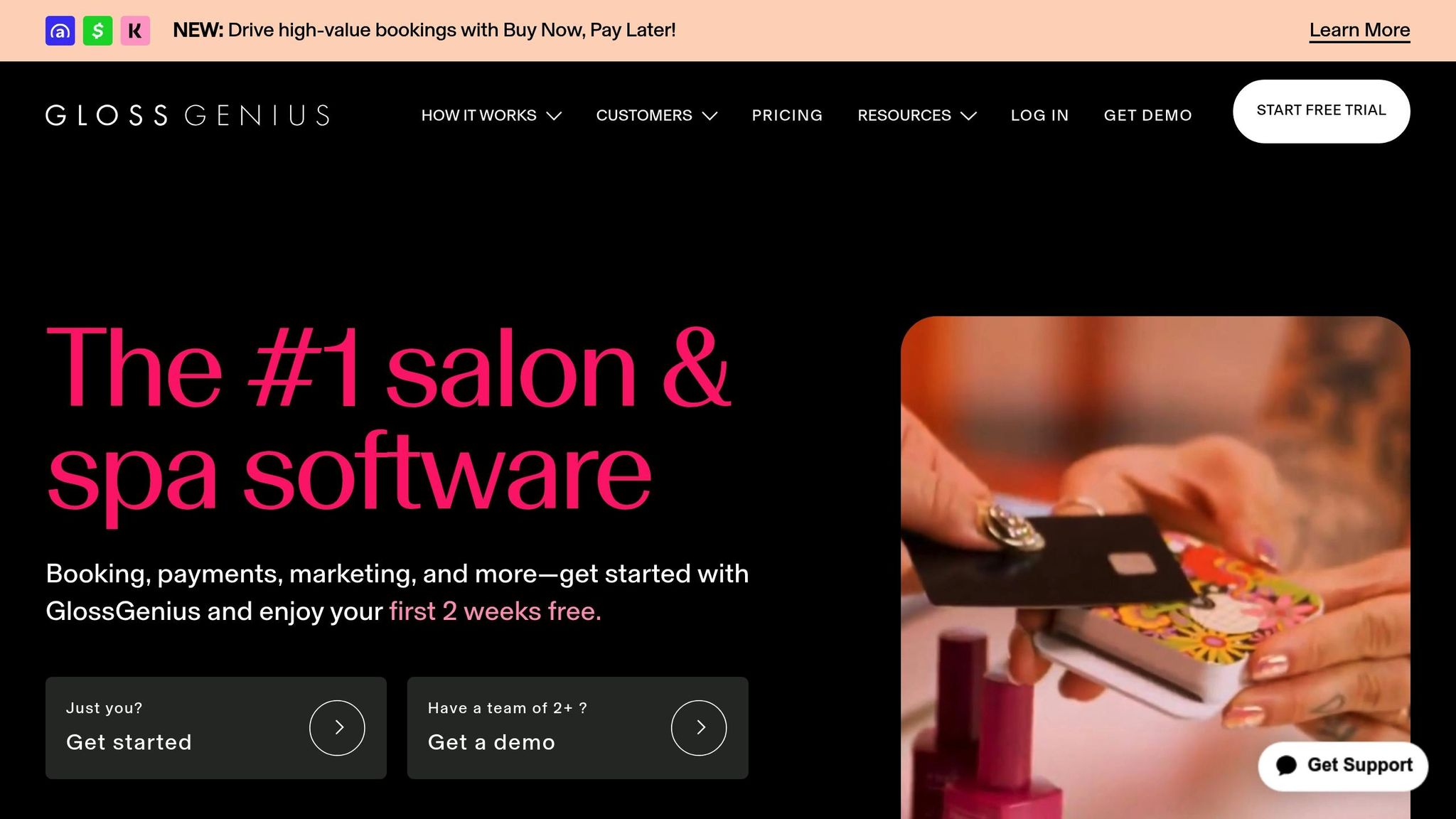
GlossGenius is a business management platform tailored for beauty professionals and salons. While it's primarily recognized for appointment scheduling and client management, it also includes tools for subscription billing, making it a good option for beauty businesses aiming to generate recurring revenue.
Recurring Payments
GlossGenius supports recurring payments through its built-in payment processing system. This feature allows beauty businesses to offer subscription services for products, memberships, or service packages. Payments are processed automatically on scheduled dates, which helps reduce the admin workload for business owners. That said, the platform’s subscription billing features are relatively simple, focusing on straightforward recurring setups rather than more intricate subscription models.
For beauty professionals offering monthly product boxes, membership tiers, or prepaid service bundles, this system works effectively. Payment failures are automatically managed with retry attempts, but the dunning management options are fairly basic and lack advanced customization.
Customer Management
When it comes to managing customer relationships, GlossGenius stands out. It offers detailed client profiles that capture service history, product purchases, preferences, and notes. This makes it easy for beauty businesses to manage subscription customers alongside regular clients.
The platform includes automated communication tools, such as appointment reminders, follow-ups, and promotional messages. These features help businesses keep their subscription customers engaged and encourage them to explore additional services or products. With client segmentation tools, businesses can target specific groups - like subscription customers - with personalized marketing campaigns.
Analytics
GlossGenius provides an analytics dashboard that offers valuable insights into business performance. It tracks key metrics like revenue, client retention, and service popularity. For businesses with subscription models, the platform monitors recurring payment success rates and customer lifetime value. However, the reporting leans more toward overall business performance rather than in-depth subscription-specific analytics.
Revenue reports combine monthly recurring revenue with income from services, giving beauty professionals a clear view of their financial health. Additionally, the system tracks client booking trends and spending patterns, which can help businesses refine their subscription offerings and optimize pricing.
Integration
GlossGenius integrates with a variety of third-party tools commonly used by beauty businesses. For financial management, it connects with accounting software like QuickBooks. It also integrates with email marketing platforms, making it easier to nurture relationships with subscription customers and promote new services or products.
Social media integration is another strong point, allowing businesses to showcase their work and attract new subscription customers through platforms like Instagram and Facebook. For those offering product subscriptions, the platform also supports inventory management integrations, which help keep stock levels in check.
4. Fresha
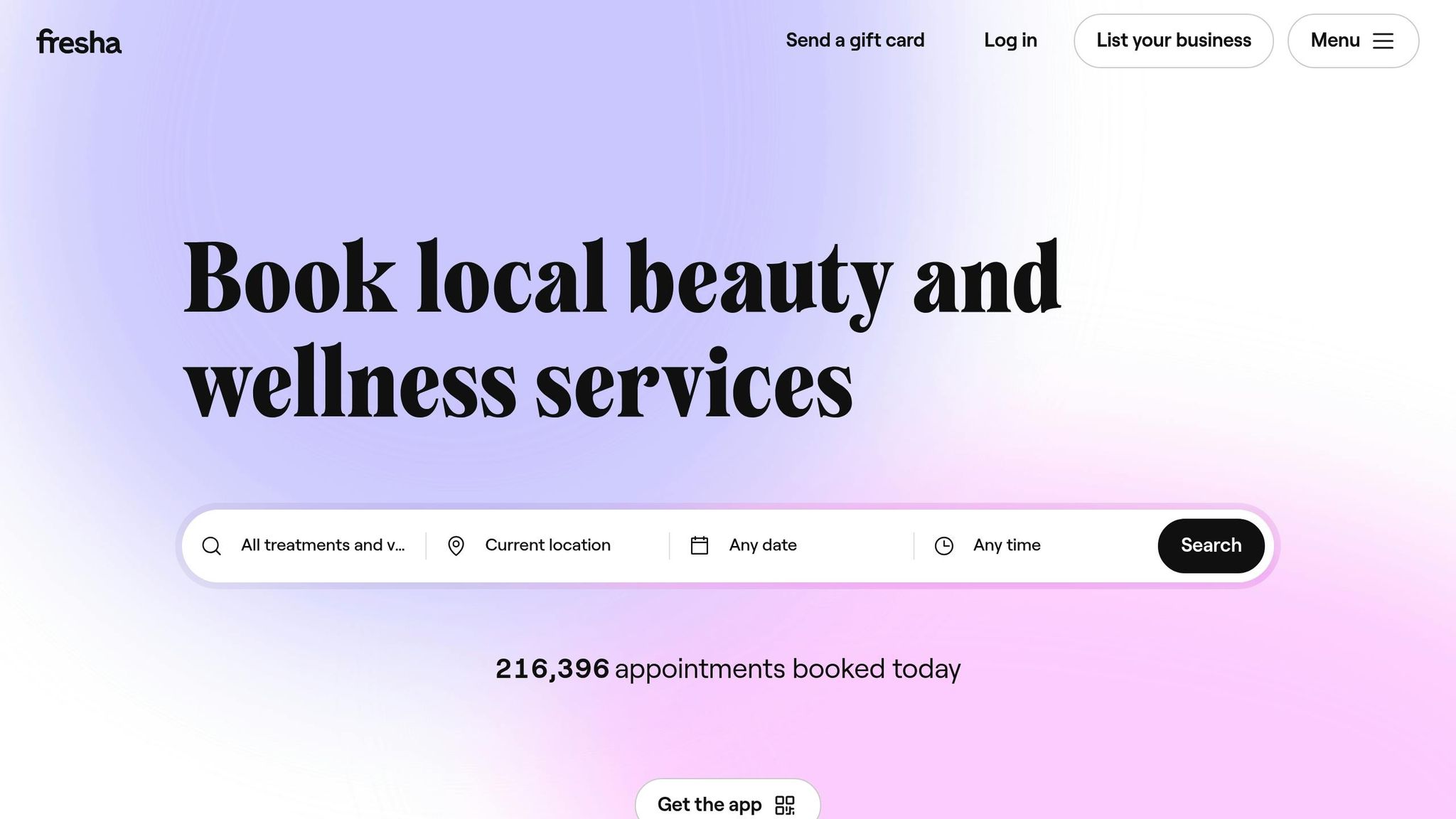
Fresha is a widely-used platform designed for appointment scheduling and salon management. It also offers advanced tools to help businesses manage their clients more effectively, improving customer retention and simplifying daily operations. These features make it particularly beneficial for subscription-based beauty businesses.
Customer Management
Fresha provides robust client management tools that give businesses valuable insights into customer behavior, preferences, and lifetime value. These insights allow businesses to create personalized experiences that not only enhance customer satisfaction but also boost sales and loyalty. Features like automated reminders and targeted marketing campaigns help reduce no-shows and encourage repeat visits.
The platform’s marketplace and online booking system make it easier to attract new clients and manage appointments. Additionally, no-show protection options, such as requiring deposits or upfront payments, help ensure client accountability. Fresha's performance data highlights its impact: businesses using the platform report a 12% increase in retention rates, an 89% drop in no-shows, and a 26% uptick in client acquisition.
5. Mangomint
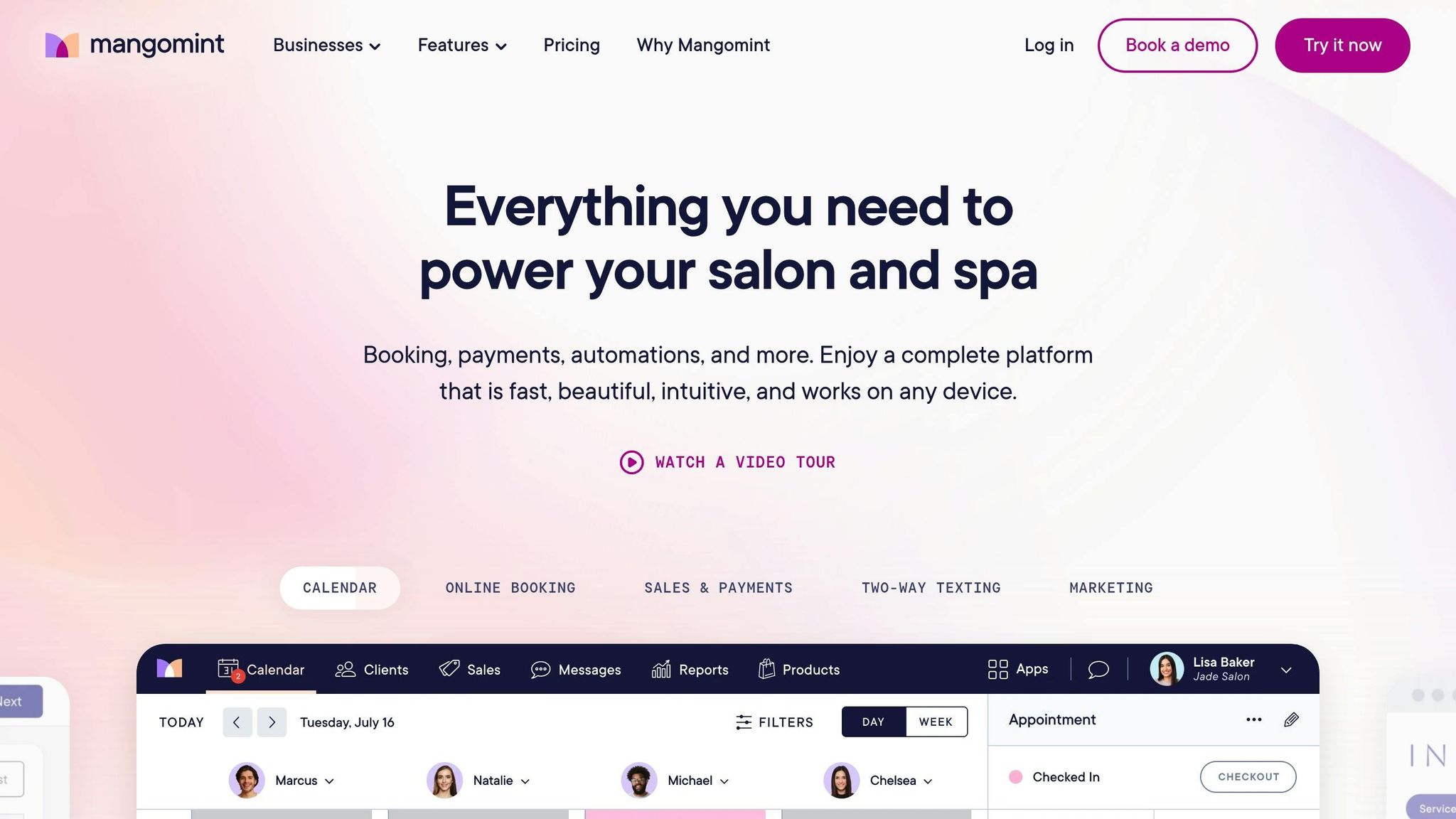
Mangomint is a platform designed specifically for salons and spas, offering tools to manage subscription-based memberships and service packages. Let’s take a closer look at how its customer management and analytics features help beauty businesses provide tailored experiences while boosting revenue.
Customer Management
Mangomint’s customer management system helps salons and spas keep track of detailed client information, such as contact details, birthdays, allergies, color formulas, and purchase history. These insights make it easier to deliver personalized services that clients appreciate. The platform also includes a client timeline feature, which automatically logs the entire client journey. This includes appointments, sales, notes, photos, and completed forms, giving beauty professionals a comprehensive view of each client’s history. It’s a handy tool for tracking progress over time and preparing for future visits.
Analytics
Mangomint provides beauty businesses with business intelligence reports tailored to their needs. These reports cover essential metrics like sales, client retention, staff performance, productivity, pre-bookings, average ticket size, and revenue forecasts. The platform is also built to support memberships and service packages, which are vital for businesses relying on recurring revenue. Its analytics tools monitor subscription performance and trends, helping businesses make data-informed decisions and predict future revenue with greater accuracy.
sbb-itb-d1a6c90
6. Recurly

Recurly is a subscription management platform designed to simplify recurring billing for businesses, including those in the beauty e-commerce space. It focuses on automating subscription processes while delivering detailed insights into revenue and customer behavior.
Recurring Payments
Recurly's billing engine supports a variety of payment models, making it a great fit for beauty subscription services. Whether it's monthly, quarterly, or annual billing cycles, the platform handles everything automatically. This is especially helpful for beauty brands offering products like skincare routines or makeup boxes that ship on different schedules.
The platform also manages dunning - a process that recovers failed payments. This is critical for beauty businesses, as customers often need to update credit cards or may experience temporary payment issues. Recurly uses smart retry logic to automatically attempt failed payments, ensuring steady revenue without requiring manual follow-up.
For businesses offering tiered pricing, Recurly makes plan changes and upgrades seamless. For instance, a customer can switch from a basic skincare subscription to a premium package with extra products, and the system calculates prorated charges automatically.
Customer Management
Recurly provides a centralized dashboard that shows payment history, plan changes, and account statuses. This helps beauty brands track customer behavior and identify subscribers who might be at risk of canceling their subscriptions.
The platform also includes automated communication tools that send payment confirmations, renewal notices, and billing updates. For beauty companies, this means customers are always informed about upcoming shipments and charges without requiring extra work from customer service teams.
Additionally, Recurly offers self-service portals where customers can update their payment methods, change shipping addresses, or adjust subscription preferences. This feature is particularly useful for beauty brands, as customers might want to pause their subscriptions while traveling or modify delivery schedules based on how quickly they use the products.
These tools not only improve the customer experience but also provide valuable data for business insights and integrations.
Analytics
Recurly's analytics dashboard tracks essential metrics like MRR (Monthly Recurring Revenue), churn rates, and customer lifetime value. These insights help beauty brands identify growth trends and assess the health of their subscription services.
The platform also includes cohort analysis, which examines how specific groups of customers behave over time. For beauty brands that rely on social media marketing or influencer collaborations, this feature helps pinpoint which campaigns bring in the most loyal and valuable subscribers.
Revenue recognition reporting is another standout feature. It simplifies financial reporting by automatically calculating revenue based on subscription terms and delivery schedules. For beauty businesses, this ensures compliance with accounting standards while aligning revenue with product shipments.
Integration
Recurly enhances its functionality through a range of integrations. It connects with top e-commerce platforms like Shopify and WooCommerce, making it easy for beauty brands to add subscription options to their online stores. Customers can even combine one-time purchases with subscription products in a single checkout.
The platform also integrates with accounting tools like QuickBooks and NetSuite, syncing subscription revenue data automatically and reducing the need for manual bookkeeping. This is a big time-saver for growing beauty businesses.
Through email marketing integrations with platforms like Mailchimp and Klaviyo, beauty brands can create targeted campaigns based on subscription status or customer behavior. For example, they can send personalized product recommendations to loyal subscribers or re-engagement emails to customers who have paused their subscriptions.
7. Maxio
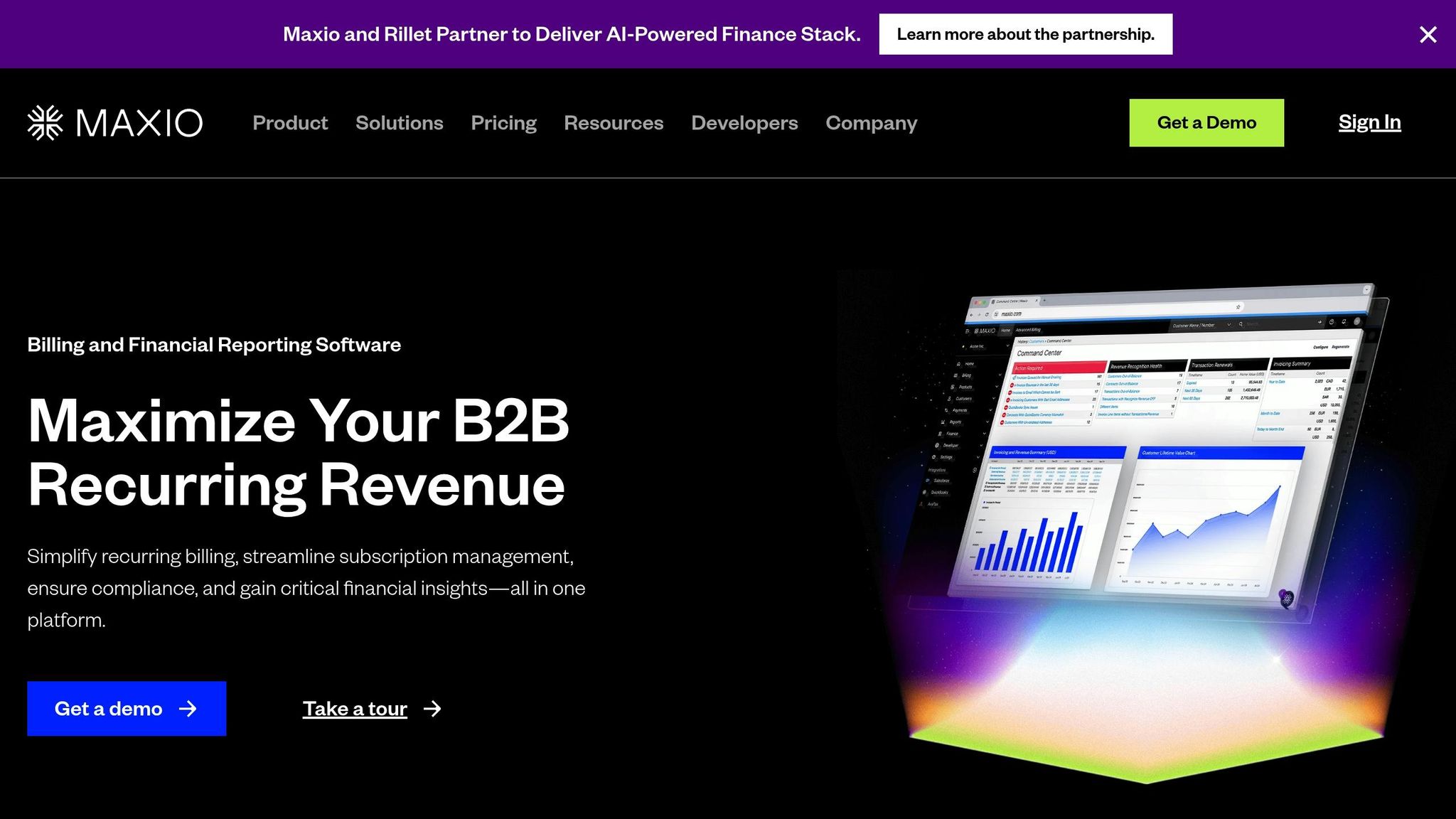
Maxio simplifies billing and financial operations for growing beauty e-commerce businesses, offering advanced tools for revenue management and reporting. Here's a closer look at how Maxio stands out with its billing features, customer insights, and integrations.
Recurring Payments
Maxio supports flexible billing setups, allowing beauty brands to combine subscriptions with one-time purchases. For instance, a customer might subscribe to a monthly skincare box while occasionally adding limited-edition makeup to their order.
The platform handles usage-based billing seamlessly. Say a customer has a $29.99 monthly subscription and schedules a $15 virtual consultation - Maxio calculates the total charges automatically.
It also manages prorated charges for mid-cycle upgrades with precision, ensuring customers are billed fairly and reducing the chances of disputes.
Dunning management is another standout feature, offering customizable retry patterns. Beauty brands can adjust retry settings based on customer segments - for example, applying more persistent retries for high-value customers who are typically reliable with payments.
Customer Management
Maxio provides detailed customer profiles that track subscription history, payment behavior, and engagement trends. Beauty brands can identify patterns, such as customers who frequently upgrade subscriptions, pause during certain seasons, or change product preferences.
The platform also segments customers by metrics like order value and subscription length, helping brands focus their marketing efforts where it matters most.
Customers enjoy flexibility, too. They can easily skip shipments, adjust delivery dates, or modify product selections. This is especially important in the beauty industry, where preferences and product usage can vary by season or personal habits.
Maxio’s customer health scores predict churn risk by analyzing payment history, engagement, and subscription changes. This allows beauty brands to proactively engage at-risk customers with special offers or personalized product recommendations.
Analytics
Maxio’s analytics provide deeper insights beyond standard subscription metrics. For example, it tracks cohort performance over time, offering a long-term view of customer behavior across acquisition channels - a critical feature for beauty brands dealing with seasonal trends.
Revenue recognition is automated and aligns with accounting standards, ensuring that quarterly shipments match monthly billing cycles.
Churn analysis is another powerful tool. Beauty brands can identify when and why customers cancel - whether it’s after their third box, during summer months, or following a price increase. These insights help refine retention strategies and product offerings.
Pricing tools allow brands to experiment with subscription tiers, discounts, and promotional offers. The impact of these strategies on customer acquisition and long-term value can be tracked, enabling data-driven decisions.
Integration
Maxio integrates seamlessly with popular e-commerce platforms like Shopify and BigCommerce, syncing product catalogs, inventory, and customer data. This allows beauty brands to manage operations from their primary platform while leveraging Maxio’s advanced billing capabilities.
For financial operations, Maxio works with ERP systems like NetSuite and Sage, ensuring that subscription revenue data integrates smoothly into broader financial reports. This is especially useful for brands selling across multiple channels.
Tax compliance is simplified with integrations like Avalara and TaxJar, which automatically calculate sales tax for shipments across various states. This is a must for beauty brands shipping nationwide, given the complexities of state tax regulations.
Finally, CRM integrations with Salesforce and HubSpot enable sales and marketing teams to access subscription data effortlessly. Brands can create targeted campaigns based on customer lifetime value, purchase history, or subscription status without manual data handling.
Advantages and Disadvantages
Here’s a breakdown of the strengths, weaknesses, and ideal use cases for each tool, based on the individual reviews.
| Tool | Strengths | Weaknesses | Best For |
|---|---|---|---|
| Chargebee | Dunning management, flexible billing cycles, revenue analytics, strong API capabilities | Steeper learning curve, premium pricing for advanced features | Established beauty brands with complex subscription models |
| Vagaro | Integrated appointment scheduling, built-in POS system, client communication tools, inventory management | Limited customization for pure e-commerce, heavily focused on service businesses | Beauty salons expanding into product subscriptions |
| GlossGenius | Mobile-first design, automated marketing campaigns, client booking integration, social media tools | Primarily service-oriented, fewer features for pure e-commerce | Independent beauty professionals and small studios |
| Fresha | Free core platform, appointment management, staff scheduling, basic payment processing | Limited billing features, fewer customization options | Budget-conscious beauty businesses starting with subscriptions |
| Mangomint | Salon-specific features, client retention tools, staff management, integrated marketing | Not designed for pure e-commerce, limited scalability for larger operations | Mid-size beauty salons with subscription add-ons |
| Recurly | Strong security, churn prevention, cohort analysis, white-label options | Complex setup process, higher cost structure, requires technical expertise | Large beauty brands with high transaction volumes |
| Maxio | Revenue recognition, usage-based billing, predictive analytics, flexible pricing models | Steep learning curve, premium pricing, may be excessive for simple subscriptions | Growing beauty e-commerce brands with complex billing needs |
Integration flexibility plays a critical role in determining how seamlessly these tools fit into an existing business setup. Platforms like Chargebee and Maxio stand out with extensive API access and pre-built integrations, making them ideal for brands with intricate tech stacks. On the other hand, service-oriented tools like Vagaro and GlossGenius excel within their own ecosystems but may require extra effort to connect with external e-commerce tools.
Pricing varies significantly across platforms. For budget-conscious startups, Fresha’s free core platform is an attractive option. Meanwhile, enterprise-grade solutions such as Recurly and Maxio come with higher price tags that align with their advanced feature sets. Beauty brands should carefully evaluate their current needs and long-term growth plans to find the right balance between features and costs.
Setup times also differ widely. Tools like Fresha and Mangomint offer quick setup processes, allowing businesses to launch basic subscription services in just a few days. However, platforms like Recurly and Maxio require a more extended configuration period - sometimes weeks or months - to unlock their full potential. Businesses should consider whether they need a fast, straightforward launch or a more robust system for future scalability.
This side-by-side comparison provides a solid foundation for making informed decisions, paving the way for final recommendations later on.
Conclusion
The U.S. beauty e-commerce subscription market is a massive $964.1M opportunity, growing at an impressive 26.6% CAGR from 2023 to 2033. This rapid growth makes choosing the right billing platform a crucial decision for businesses in the space. Different platforms cater to specific business models, so understanding your needs is key.
For businesses that combine appointments with product subscriptions, service-focused platforms like Vagaro, GlossGenius, and Mangomint are strong options. On the other hand, e-commerce-oriented solutions such as Recurly and Maxio are better suited for handling complex billing needs in high-volume operations. The challenge lies in aligning platform features with your operational goals, growth plans, and technical requirements.
With the average U.S. adult spending $1,080 annually on subscriptions, beauty brands must prioritize user-friendly billing systems to tap into this expanding market. Features like churn management, dunning tools, and revenue analytics become increasingly important as businesses scale beyond basic subscription models.
Integration flexibility is another critical factor, especially for brands operating within larger tech ecosystems. Platforms with robust API access and pre-built integrations can drastically reduce the headaches of system compatibility. Additionally, setup timelines can vary widely - from a few days for simpler platforms to several months for enterprise-level solutions - making careful planning essential for a smooth launch.
Navigating the wide array of features, pricing structures, and technical complexities can feel overwhelming. That’s where BizBot comes in. This tool provides a curated directory of business administration platforms, including subscription management solutions, helping beauty e-commerce brands find the right fit without hours of research. It’s a one-stop resource for staying informed on the latest tools and trends.
FAQs
How can subscription billing tools help beauty e-commerce businesses meet compliance requirements like PCI DSS, ASC 606, and CCPA?
Subscription billing tools play a crucial role in helping beauty e-commerce businesses stay on top of compliance requirements by automating essential processes and ensuring regulations are followed.
- PCI DSS Compliance: These tools enhance payment security by using secure payment gateways and safeguarding sensitive customer information.
- ASC 606 Compliance: They simplify revenue recognition by automating the tracking of contracts and performance obligations, ensuring financial reports are accurate.
- CCPA Compliance: Subscription tools assist in managing customer data privacy and consent, reducing the risk of violations and protecting consumer rights.
By incorporating these capabilities, subscription billing tools not only make regulatory compliance easier but also help businesses build customer trust and streamline their operations.
What are the main differences between Chargebee and Recurly for managing complex subscription models in beauty e-commerce?
Chargebee and Recurly are both powerful options for handling subscriptions, but they shine in different ways. Chargebee is packed with tools for billing automation, tax compliance, and creating custom pricing structures. This makes it a great choice for businesses dealing with international markets or complex pricing needs.
Meanwhile, Recurly specializes in managing the subscription lifecycle. It offers features to tackle churn and test flexible pricing strategies, making it a strong contender for beauty brands or businesses with customizable subscription models.
Choosing between the two comes down to your priorities: if you need comprehensive billing capabilities, go with Chargebee; if reducing churn and optimizing the subscription experience is your focus, Recurly might be the better fit.
What factors should beauty e-commerce businesses consider when choosing a subscription billing tool that aligns with their size and growth goals?
When selecting a subscription billing tool, beauty e-commerce businesses need to consider their current size, future goals, and operational requirements. The right choice depends on balancing automation, scalability, and customer experience.
If you're running a smaller business, focus on tools that are straightforward and include must-have features like recurring payment processing and basic analytics. On the other hand, businesses with plans to grow should seek tools with advanced capabilities. These might include customizable pricing models, automated revenue tracking, and the capacity to manage an expanding customer base without hiccups. Choosing a tool that can grow alongside your business will help maintain efficiency and support long-term success.
